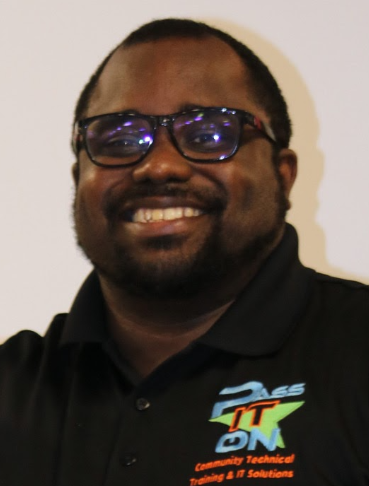If traditional university education was the only route into tech, Willie Sanders Jr. wouldn’t be in the field right now.
“I’m a professor at the school I dropped out of,” the founder and executive director of Pass IT On told Technical.ly. This detail encapsulates the non-traditional journey Sanders took to his current role, through which he aims to get more people into tech.
Sanders knew he wanted to work with computers since he was 14 and his mom brought home the family’s first PC. He was so obsessed with them that he dreamed in pop-up windows. This passion remained with no outlet until his first semester at Towson University.
Back then, Towson’s only tech industry major was computer science. These courses involved coding and software programming Sanders had no prior experience with. The material his night class professor taught was going over his head, and nobody cared. The frustration boiled up and he eventually dropped out.
“Now I get to be a professor at the university and make sure anybody that’s drowning can at least have one professor who knows what they’re going through, and can give them that life raft to pull them back in,” Sanders said. He’s now a full-time professor at Towson teaching computer networking and cybersecurity.
Sanders’ experience echoes larger issues with tech education, pipelines and diversity. The National Center for Education Statistics reported that of the 97,047 computer science degrees awarded in 2020, only 8.4% went to Black students while nearly half went to white ones. Sanders’ experience shows what happens when K-12 schools lack computer science courses, which also possibly explains why those figures are so low.
After dropping out, Sanders found tech training nonprofit Byte Back, where he learned the skills to get a CompTIA Network+ certification. With the cert alone, he got his first IT job with the Internal Revenue Service’s (IRS) IT helpdesk. The rest is history.
Sanders made his own college scholarship route through his various IT jobs. The company staffing the IRS’s IT helpdesk paid for his associate’s and bachelor’s degrees while Baltimore City Public Schools paid a good portion of his master’s one. Pearson, the standardized testing company, paid half of his doctorate.
“Because of the roles we play in organizations,” Sanders explained, “good companies are willing to invest in you.”
To get where he’s at today, Sanders applied the education concept called “backward mapping” to his everyday life. Essentially, it’s the concept of working with the end in mind. For teachers and educators, it’s setting a goal for learning outcomes then forming lesson plans from there. In Sanders’ life, the concept involved setting a career goal before outlining the steps to achieve it. He wanted to teach at a four-year university, as well as graduate from Towson — the school he dropped out of.
“This is my 10-year goal,” Sanders said. “What should I be doing for the next five years in order to get there? What should I be doing for that next one year to get to that five-year goal? I mapped that all the way down to what I should be doing, day by day, in order to make that ten-year goal happen.”
Here are some of the tips and advice Sanders learned along the way and wants to pass on to those behind him:
- “The right certification with some practical experience and education, then you can get [that IT job].”
- Volunteering with small businesses or nonprofits is a great way to get experience to break into IT: “There’s this catch-22 in IT. A lot of companies don’t want to give you the job until you get experience, but you can’t get experience until you get the job. You’re caught in this cycle, but the way out of it is through volunteerism.”
- Keep an eye out for emerging technologies: “It would have been cool to know in advance, five years before everyone got into cloud, that cloud was a thing.”
- If you’re switching to tech from another career, you don’t need to dump that prior knowledge and start over from scratch: “You just have to figure out how you can leverage that prior knowledge correctly. Combine it with the right tech training and it will set you up to take on a tech role now in the industry you’re already working in.”

This is How I Got Here, a series where we chart the career journeys of technologists. Want to tell your story? Get in touch.
Before you go...
To keep our site paywall-free, we’re launching a campaign to raise $25,000 by the end of the year. We believe information about entrepreneurs and tech should be accessible to everyone and your support helps make that happen, because journalism costs money.
Can we count on you? Your contribution to the Technical.ly Journalism Fund is tax-deductible.
Join our growing Slack community
Join 5,000 tech professionals and entrepreneurs in our community Slack today!

The person charged in the UnitedHealthcare CEO shooting had a ton of tech connections

The looming TikTok ban doesn’t strike financial fear into the hearts of creators — it’s community they’re worried about

Where are the country’s most vibrant tech and startup communities?


